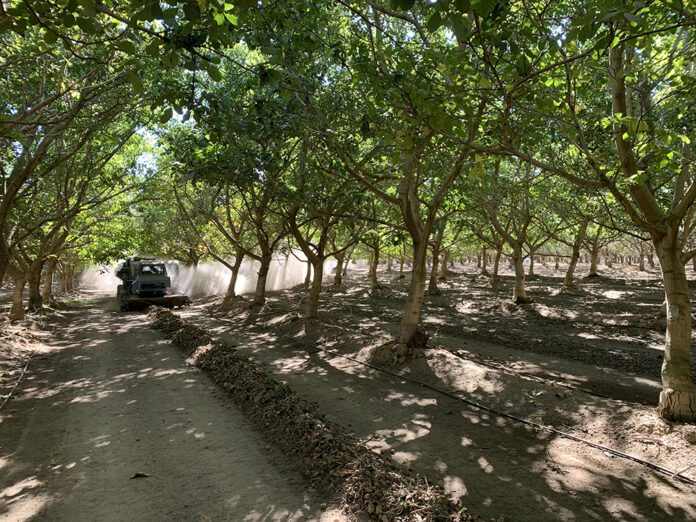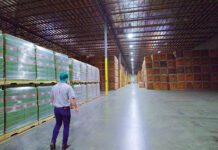The changes are real; weather events are stronger, weather-driven pest pressures are up, market prices are more volatile and regulatory and market pressures are growing. Many of these changes (weather, markets, regulation) are largely out of growers’ control. What can growers do to respond and stay in business? What good growers have always done: Be alert, discuss options with as many creditable sources as possible and adjust plantings and practices in response to changes. Credible sources include trusted friends, advisors (PCAs and CCAs), processors, industry leaders, manufacturers and cooperative extension advisors and researchers.
A valuable source of information for Sacramento Valley tree crop growers is the Nickels Soils Lab (NSL) in Arbuckle (Colusa County). The following are recent research results from work at Nickels broken out into sections on production, cost savings and successful practices addressing long-term regulatory trends.
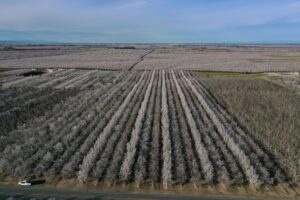
Almond Production
Results from long-term research at the Nickels Soil Lab may help growers understand factors affecting yield and plan for the most resilient plantings to contend with changing weather patterns and volatile markets.
Consistent production keeps cash flowing and farms in business. However, recent variable spring weather has meant inconsistent production for many Sacramento Valley almond growers using traditional Nonpariel and pollinizer plantings. The last seven years included two bloom seasons with excellent bee activity and nut set (2020 and 2024), two February frosts (2018 and 2022) and two years with cold and/or wet springs and reduced bee activity (2019 and 2021).
Set against the variable spring weather, a solid Independence variety planting at Nickels yielded more consistent crops compared to a 50% Nonpareil/25% Aldrich/25% Sonora planting. While the real “yo-yo” variety production was from Sonora, Nonpareil yields varied by 500 to 900 lbs/acre/year while Independence production varied by much less (200 to 400 lbs/acre/year). Given this planting is on the moderately vigorous Viking rootstock and the Independence trees are a third smaller than the Nonpareil trees, Independence yields in this trial would have looked even better if the Independence and Nonpareil trees were similar sized. Many growers in the Sacramento Valley are now planting Independence on vigorous peach/almond hybrids (Hanson, etc.) to grow a bigger tree and increase yields per acre.
The take-home suggestion from this research is Independence plantings, allowed to fill their space with proper rootstock selection and tree spacing, have a good chance of delivering more consistent production over time than Nonpareil/pollinizer plantings. This could be more important for growers in Sacramento Valley with, on average, cooler and wetter springs compared to the San Joaquin Valley. It remains to be seen if these results are repeated in other growing regions of the Sacramento Valley.
Plantings with the potential for occasional very high yield and value also can have a place in a grower’s planting portfolio. Nonpareil is still the highest-priced nut on the market, and Nonpareil-focused plantings (≥50% Nonpareil) can bring windfall returns with excellent bloom weather, depending on market conditions. Therefore, information on how to get the best return from Nonpareil in a great production year (think 2020) can have value to growers.
In a tree spacing trial planted at Nickels in 2017, Nonpareil on ‘Titan’ peach/almond hybrid (with Aldrich and Kester pollinizers) produced significantly greater yields (10% to 15% more crop) at 12-ft or 14-ft spacing down the row compared to 16-ft or 18-ft down the row, but only in years with good bloom weather (2020, 2023). In years with wet/cool springs, no yield differences existed regardless of tree spacing.
Pollinizer selection is also critical to the success of Nonpareil/pollinizer orchards, not so much as a pollen source for the Nonpareil, but as an income source. In a comparison of Nonpareil production and income between three pollinizer choices planted at Nickels by John Edstrom, retired UCCE orchard advisor in Colusa County, the 50/25/25 combination of Nonpareil/Winters/Monterey tended to produce more value than 50/25/25 Nonpareil/Fritz/Monterey or 50/25/25 Nonpareil/Aldrich/Winters. The differences, though minimal, are due to the occasional ‘off’ years for Aldrich and/or Fritz and the generally more consistent production from Winters and Monterey.
For a single farming operation with multiple orchard sites in the Sacramento Valley, a mixture of Nonpareil/pollinizer and solid Independence (or other self-fertile varieties?) plantings in separate orchards may provide a better long-term income result compared to multiple plantings of the same varieties. If future weather is as variable as the last decade, combinations of different orchard systems (self-fertile and traditional Nonpareil/pollinizers with tighter spacing) may deliver the best returns over time compared to just plantings of one system. At least it’s food for thought, supported by local research results. Individual farming operations must decide planting plans based on local conditions (location, income needs, etc.).
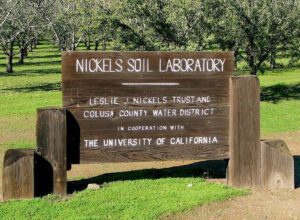
Walnut Production
Changing weather is also a risk to walnut production. Walnuts need a lot of chilling. Warmer winters mean less chilling resulting in delayed or erratic bloom. Nickels is hosting one of several rest-breaking trials conducted by Dr. Katherine Jarvis-Shean, UCCE orchard systems advisor in Sacramento, Solano and Yolo counties. In the first year of the Nickels trial (2023), walnut yield was increased by several treatments applied in early March, but additional years of work will be needed to determine if the rest-breaking treatments will pay.
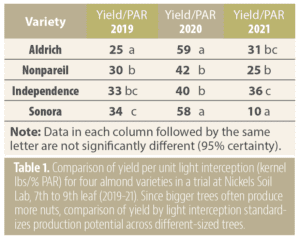
Managing Costs
Reducing grower costs while maintaining quality production is an immediate priority for growers. The success of the Independence trial at Nickels and the reduction in bee stocking rate in Independence (one hive/acre for Independence compared to two hives/acre for plantings of Nonpareil and pollinizers) saves growers about $200/acre. See more information on bee stocking rate research by UC Davis’ Dr. Elina Niño for Independence almonds in the link at the end of this article (this research documented an increase in yield when one hive/acre was used compared with no added bees.)
Pruning trials in almond and walnuts, conducted at Nickels in almonds by John Edstrom and Bill Krueger and in walnuts by UC Davis’ Dr. Bruce Lampinen along with UCCE Advisors Edstrom, Janine Hasey and Caroline DeBuse demonstrated pruning is not needed (after the first dormant season) to deliver excellent yield of high-quality nuts. This amounts to significant savings to growers in labor and brush removal over the years. In young walnuts, no pruning after the first leaf increased cumulative yield in the 4th leaf by 1 ton/acre over heavily pruned trees. From the 5th leaf onward, cumulative yield was no different between the pruning treatments.
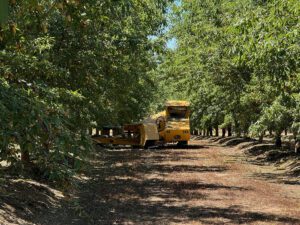
Whole Orchard Recycling
What to do with old orchards in the future? Before long, field burning may be significantly limited in the Sacramento Valley (it already is in the San Joaquin Valley.) Co-gen options are limited, too. One option to dispose of an orchard is to grind the old trees and spread the chips across the site, then rip and disc to prep the site and incorporate the chips. This practice is called “whole orchard recycling” or WOR.
A WOR trial was planted at the Nickels Soil Lab in 2019. To date, the addition of 25 to 50 tons of chips per acre, pre plant, has not impacted new orchard tree growth or yield in this 20-acre trial. The orchard was fallow for two years before planting in 2019 and a vigorous rootstock (Nickels peach/almond hybrid) was used. While some growers have tried this practice on their own in the Sacramento Valley, besides Nickels Soil Lab, there are no sites where growers can see the trees and compare yield between chipped and no chipped.
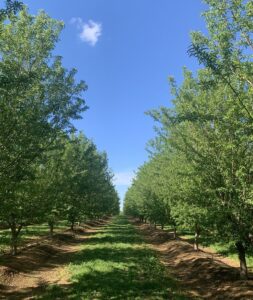
Airblast Spraying
Trials at Nickels measured 50% loss in spray coverage in upper (15 to 20 ft) canopy of mature trees when sprayed in late morning (11 a.m.) compared to spraying in the early morning (6:30 a.m.) on the same day in June. Spraying when relative humidity is above 50% (no lower than 40%) is recommended to deliver maximum spray coverage in the upper canopy and worm and mite control during the summer months.
In addition, the use of low-drift nozzles (TeeJet AITX Conjet or Albuz TVI 80) in hull split sprays did not harm navel orangeworm control in several years of trials compared with conventional nozzles (TeeJet disc+core, TeeJet TXR Conejet, or Albuz ATR 80) when used at full spray volume (150 to 200 gallons per acre). Controlling pests and drift is critical to successful orchard production.
Finally, tracer studies showed using higher water rates did not reduce spray deposition even though the spray solution was diluted. That is, using 200 gallons per acre (gpa) of spray compared to 100 gallons per acre at the same rate per acre of product in the tank did not reduce the amount of chemical reaching the nuts at hull split. More spray reached the nuts at the higher rate compared to the lower spray volume, balancing out the fact that twice the water per acre meant the tank concentration at 200 gpa is half of what it is at 100 gpa. High spray volume with materials such as Intrepid and Altacor, which require excellent coverage on the nuts at hull split, delivers the best navel orangeworm control in multiple tests up and down the Sacramento and San Joaquin Valleys, including at Nickels.
These are a few of the research results coming from the work at Nickels Soil Lab in the last decade. Keep up with Nickels research by checking the poster at the Almond Board Conference in Sacramento on December 11 and by watching for announcements of the Nickels Field Day in early May 2025.
Best wishes for a safe and successful harvest for all.
References
Rest breaking trials in walnut by Dr. Katherine Jarvis-Shean:
fruitsandnuts.ucdavis.edu/collaborators/california-walnut-board/reports
sacvalleyorchards.com/walnuts/horticulture-walnuts/winter-chill-dormancy-and-walnut-management-2023-2024-update/
Bee stocking rates in self-fertile almonds by Dr. Elina Niño:
beeculture.com/research-at-the-e-l-nino-bee-lab-at-uc-davis-part-2/







